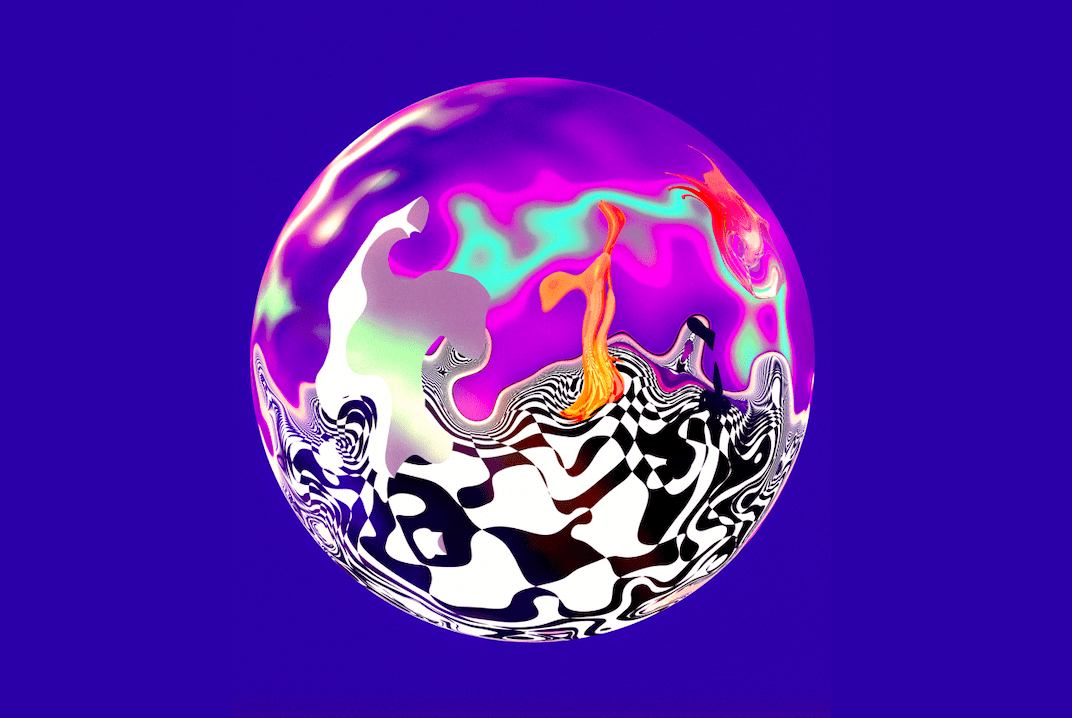Read the first text from our new Print Issue #11 entitled Conscious Codes, Anyone? focusing on digital arts and their potential for connecting to the past and inventing the future. This interview with cover artist David Alabo dives into his Afro-surrealistic approach, he uses to visually articulate digital African landscapes that are speculative, familiar, and fantastical. Based in Accra, the artist has a unique Moroccan Ghanaian identity and forged his creative personality in Italy, Ghana, and the United States. Alabo’s strange and eerie images are fashioned by software, with all its possibilities for productive manipulation.

David Alabo, Dream Bubble, 2019. Digital Art Print. Courtesy the artist
Fragments of Accra, such as the skull, often feature in Alabo’s work—“a statement that is both metaphorical and political about trader women who balance their livelihoods upon their craniums.” His images of an undulating Sahara express loneliness, alluding to states of isolation and alienation associated with mental illness, which the artist thinks needs urgent attention among African peoples. His other concerns include the gendered identities of his subjects, which he obfuscates by creating isolated androgynous figures negotiating vast desertscapes.
The sum of his work is a kaleidoscopic rendering of Africanity through juxtapositions of African tropes and imaginaries, with a chromatic, shiny quality, that he describes as “reflective points,” in both metaphorical and literal terms. In this interview, Russel Hlongwane speaks to the artist about black mirrors, the tradition of surrealism in Africa, and the possibilities of digital art.
Contemporary And: Let’s talk Afro- Surrealism, within which I include the traditions of folklore and the literature of Ben Okri and Ngũgĩ Wa Thiong’o. What is your version of surrealist history in Africa, and how have these authors informed the visual manifestation of your practice?
David Alabo: Surrealism is the perfect genre to describe the complicated and abstract experience of Blackness. It allows an artist to express unfiltered thoughts and emotions in the work, the same way writers do with language. Afro-Surrealism focuses on augmentation, on overcoming the many struggles that define our history and assuming the agency of our narrative.
It calls on us to ask what freedom for Black people will look like in the future. Futurism and Surrealism are similar in that they both rely heavily on the speculative—endless possibilities that continue to change, with time as the main influence.
C&: Where or how do you situate your work within the Afro-Surrealist lineage, given that it is screen based?
DA: My work is as informed by the past as it is by the present. We live in a world that is dominated by “black mirrors” or screens. Art has transcended the physical realm into the virtual and so have the artists and media that accompany it. We show our works on virtual platforms, so why not make art the same way?
C&: Do you believe in problematizing the term “Afro-Futurism(s),” as some critics argue for, owing to its history and reductive aesthetic matrix?
DA: “Afro-Futurism” gained popularity as a means to describe a movement and way of thinking established long before the term’s inception. Exploring identity within the context of alienation and displacement in order to envision alternative realities is a natural part of the Black experience.
Creating and questioning the status quo is just as important as the meaning behind the art. It’s empowering to have that freedom of expression. Our imagination is informed by the past and is inseparable from our visions of the future. Afro-Futurism is more than an aesthetic trend—it’s a beacon of hope and an escape from the harsh realities of the now.
C&: I am interested in your collaborations with commercial entities like fashion brand Daily Paper and media company Quartz. How does this work exist alongside your Afro-Surrealist practice?
DA: When you work to create new worlds with people who share your vision, there is a freedom and trust that allows you to explore concepts without hesitation. Daily Paper is dedicated to promoting African culture by honoring the past and its influence on creating a vision of the future. The company pushes the boundaries and challenges perceptions of Africa in the fashion world, which is what I aim to achieve in the art world too. It just makes sense that we work together and inspire each other.
C&: What possibilities does digital art present?
DA: The way we absorb and appreciate art is evolving as fast as the tools and technology we use to create as digital artists. That, together with the impact of years of social media and advertising, means we are almost hardwired to look out for media that are engaging and fluid with motion. Digital art merges seamlessly with the exciting world of augmented reality to add a new way of interacting with art and our perception of reality. We are on a continuous search for new tools to express ideas that are as unique as they are.
Russel Hlongwane is a cultural producer and creative industries consultant based in Durban. His work obsesses over tensions in Heritage/Modernity and Culture/Tradition as they apply to Black life. His said practice includes cultural research, creative production, design, and curatorship.
More Editorial